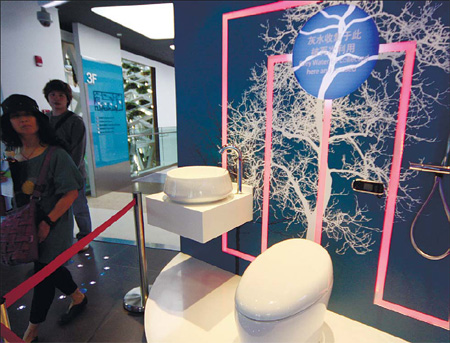The urban experience at Expo
 |
| Visitors check out a water-saving bathroom at the Shanghai Case Pavilion. |
Shanghai has always been a city open to the influence of many cultures, combining the best parts of these cultures to create a city with its own unique features.
The Expo 2010 Shanghai has brought another great opportunity to satisfy its thirst for knowledge and influence.
The Urban Best Practices Area (UBPA), a first-time feature of World Expos, has attracted many visitors since the Expo opened. The UBPA is a platform for cities to exhibit and showcase their most successful initiatives of various urban experiences, all of which focus on how to improve the quality of life for residents.
"It is a chance for cities to learn from each other," said Sun Liansheng, director of the UBPA in the Expo Garden. "Each city has its own level of development, and not all cities can share and use all the same solutions."
Many factors account for the modernization of a city. Not only does it include a city's industrial level, but also the conveniences provided to residents, including transportation and housing systems. These are some of the most important issues for the sustained development of a city, especially for Shanghai because of its size and ever-increasing population.
Hong Kong, one of the most developed cities in Asia, is highlighted by its residents' convenient lifestyle. The city's Octopus card, a rechargeable, stored-value smart card, allows holders to access more than 2,500 service providers, including public transport operators, convenience stores, retail outlets and fast food chains.
"We've spent more than 10 years developing the smart card system, which we believe Shanghai can do in the future as it has such a great foundation," said a spokesman for Hong Kong's Case Pavilion.
Shanghai remains a city with many opportunities attracting people from all over China and abroad. The city has also seen record-breaking housing prices from the influx of outsiders, leaving some unable to find affordable housing.
Similar to Shanghai, Madrid had the same issue of providing efficient and affordable housing. Madrid has relieved the strain on residents caused by the housing market by providing alternatives.
Buildings constructed using high-tech, low-cost materials make efficient use of energy and provide comfortable housing to residents. Through these projects, Madrid has become famous for its excellent public housing system.
"I think it would be quite possible for Shanghai to adapt the model of our bamboo house project for social housing," said Ignacio Nino, commissioner general of the Madrid Case Pavilion. "However, this was built with Madrid's climate and urban development in mind."
In order to make this concept effective in Shanghai, it would need to be changed. "We keep in mind the need for building under sustainable principles, which can be applied to any dynamic and upwardly mobile society like the one in China," he said.
 0
0 







Go to Forum >>0 Comments